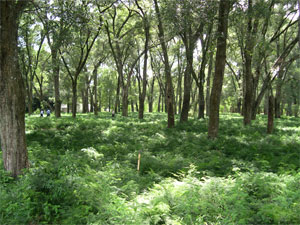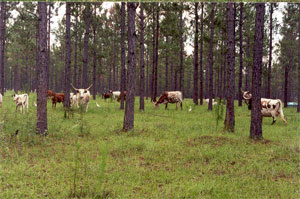Ornamental Foliage Production under Oak Tree Shade
There are many growers involved in Florida's fern and ornamental foliage business, but not many use forest farming techniques to raise sun-sensitive plants. Homer and Rose McMillen, owners of Arbors of Ivy nursery near DeLand, Florida, have successfully practiced forest farming for over 30 years.
The McMillens were a highlight of one of the field tours conducted during the recent World Congress of Agroforestry in Orlando. Sarah Workman of the University of Georgia organized and led the field trip, which also included a visit to the Ocala National Forest.
 |
'Sprengeri' asparagus ferns are one of the ornamental foliage crops raised in the shade of native myrtle oak trees at the Arbors of Ivy Nursery near DeLand, Florida.. (Photo by M. Merwin) |
Arbors of Ivy produces more than 70 varieties of ornamental foliage which they cut and ship to order. They are one of the nation's largest suppliers of cut ivy, offering over 40 different varieties. Garlands are a specialty business for Arbors of Ivy along with ivy baskets, ivy topiaries and herbs.
Central Florida is the center of a large fern and cut foliage industry which, according to the Commissioner of Agriculture, generated sales of over $85 million (1997) from more than 7,000 acres.
For many of their field grown plants, the McMillens take advantage of natural shade afforded by native, evergreen myrtle oak trees (Quercus myrtifolia) that cover much of their 40 acre property. Many different species of shade-tolerant plants are grown in the understory below the oaks, such as asparagus fern (Asparagus densiflorus "Sprengeri") and hydrangea (Hydrangea sp.).
For more information, contact the nursery at This email address is being protected from spambots. You need JavaScript enabled to view it. or visit their website, www.arbors-of-ivy.com.
By Miles Merwin, Editor
- Details
- Written by Miles Merwin
- Parent Category: 2004 Vol. 12
- Category: July No. 3




